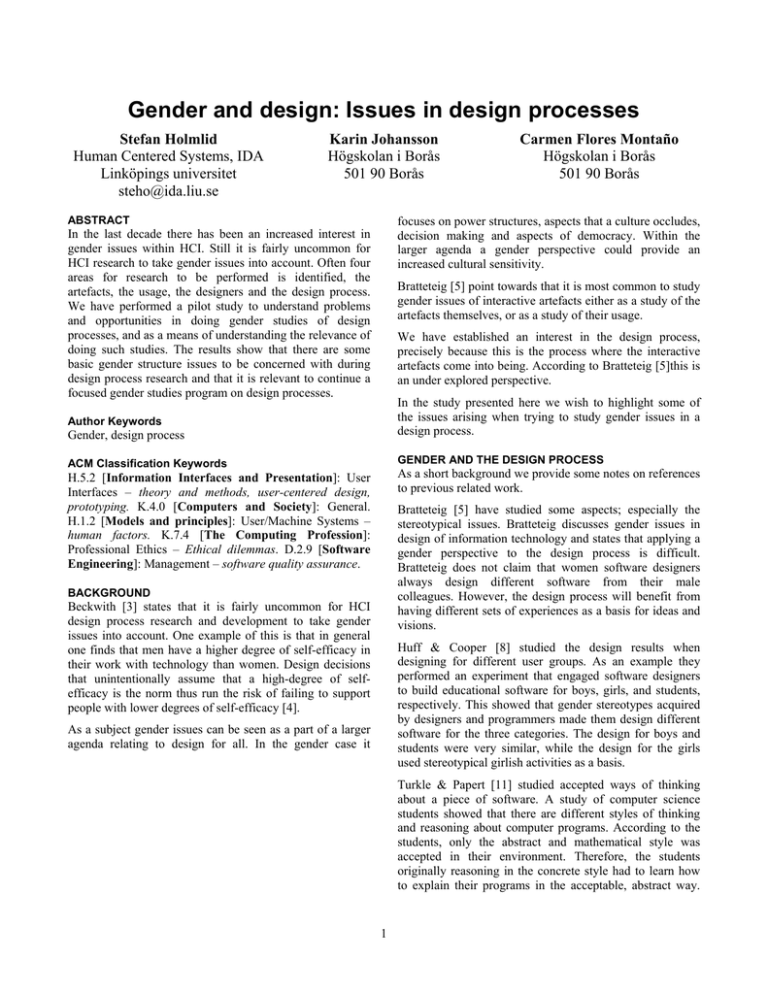Gender and design: Issues in design processes
advertisement

Gender and design: Issues in design processes Stefan Holmlid Human Centered Systems, IDA Linköpings universitet steho@ida.liu.se Karin Johansson Högskolan i Borås 501 90 Borås ABSTRACT Carmen Flores Montaño Högskolan i Borås 501 90 Borås focuses on power structures, aspects that a culture occludes, decision making and aspects of democracy. Within the larger agenda a gender perspective could provide an increased cultural sensitivity. In the last decade there has been an increased interest in gender issues within HCI. Still it is fairly uncommon for HCI research to take gender issues into account. Often four areas for research to be performed is identified, the artefacts, the usage, the designers and the design process. We have performed a pilot study to understand problems and opportunities in doing gender studies of design processes, and as a means of understanding the relevance of doing such studies. The results show that there are some basic gender structure issues to be concerned with during design process research and that it is relevant to continue a focused gender studies program on design processes. Bratteteig [5] point towards that it is most common to study gender issues of interactive artefacts either as a study of the artefacts themselves, or as a study of their usage. We have established an interest in the design process, precisely because this is the process where the interactive artefacts come into being. According to Bratteteig [5]this is an under explored perspective. Gender, design process In the study presented here we wish to highlight some of the issues arising when trying to study gender issues in a design process. ACM Classification Keywords GENDER AND THE DESIGN PROCESS Author Keywords As a short background we provide some notes on references to previous related work. H.5.2 [Information Interfaces and Presentation]: User Interfaces – theory and methods, user-centered design, prototyping. K.4.0 [Computers and Society]: General. H.1.2 [Models and principles]: User/Machine Systems – human factors. K.7.4 [The Computing Profession]: Professional Ethics – Ethical dilemmas. D.2.9 [Software Engineering]: Management – software quality assurance. Bratteteig [5] have studied some aspects; especially the stereotypical issues. Bratteteig discusses gender issues in design of information technology and states that applying a gender perspective to the design process is difficult. Bratteteig does not claim that women software designers always design different software from their male colleagues. However, the design process will benefit from having different sets of experiences as a basis for ideas and visions. BACKGROUND Beckwith [3] states that it is fairly uncommon for HCI design process research and development to take gender issues into account. One example of this is that in general one finds that men have a higher degree of self-efficacy in their work with technology than women. Design decisions that unintentionally assume that a high-degree of selfefficacy is the norm thus run the risk of failing to support people with lower degrees of self-efficacy [4]. Huff & Cooper [8] studied the design results when designing for different user groups. As an example they performed an experiment that engaged software designers to build educational software for boys, girls, and students, respectively. This showed that gender stereotypes acquired by designers and programmers made them design different software for the three categories. The design for boys and students were very similar, while the design for the girls used stereotypical girlish activities as a basis. As a subject gender issues can be seen as a part of a larger agenda relating to design for all. In the gender case it Turkle & Papert [11] studied accepted ways of thinking about a piece of software. A study of computer science students showed that there are different styles of thinking and reasoning about computer programs. According to the students, only the abstract and mathematical style was accepted in their environment. Therefore, the students originally reasoning in the concrete style had to learn how to explain their programs in the acceptable, abstract way. 1 Designer Researcher LoFi Notes List LoFi LoFi User Design Re- design test prio design Video/audio/note-taking FIGURE 1. THE DESIGN PROCESS Turkle & Papert claim that most of the students reasoning in the concrete style were women. second part will point towards the problems in performing this kind of study of a design process. Other studies [1, 7] point towards how communicative patterns and structures are established. Issues in the process The female design-group spent their last minutes of the initial design to prioritise and add what they believed to be necessary functionality, and still felt they had not included everything they wanted. The male design-group spent their last minutes decorating the interface, even though they believed there was functionality missing. These two results reinforce each other, in the sense that the female designgroup was focusing on utility, while the male design-group was focusing on symbolic values. This is a gender issue on the view of technology that is confirmed by Turkle & Papert [11]. There is a wide variety of gender studies research to be found, and areas to look more deeply into for future studies would be technology education and use, management and decision-making, etc. STUDYING THE DESIGN PROCESS The study we perform should be viewed as a pilot study, and as a means of understanding problems and opportunities in doing gender studies of design processes, and as a means of understanding the relevance of doing such studies. The male design-group during the initial part of the test asked the test persons “What do you believe this is for?”. The female design-group performed the user test according to the instructions. These results point towards the attitudinal difference that male users act as if they have more self-efficacy with respect to technology [4]. In this case the male design-group assumes that everyone shares their confidence, and acts as if that were the norm. We set up a small and in some ways idealized design process, in order to be able to study the relevance of doing gender studies and to find problems and opportunities with doing gender studies of a design process (see figure 1). We focused on the communication and decision making by the designers in the process. They were given a design task that they were supposed to perform through all the steps of the prescribed design process. By recording, note taking, and a debriefing, we wanted to collect data on the communication and decision-making. Both design-groups ranked a comment from a male tester as being the most important for re-design. For the male design-group two out of five prioritised comments originated from a male tester. For the female design-group one out of four prioritised comments originated from a male tester. In other communicative and decision-making processes male speakers expect to gain more interest and attention than they pay female speakers [1], which supports this result. Combining this with the fact that most comments during the tests originated from female-testers the few male-tester comments seem to have been regarded as more important, or of higher quality, than a lot of the female-tester comments. There were two design groups. One group consisted of only male designers, and one of only female designers. They evaluated their lofi-prototype with two groups of users; both groups consisted of two persons, one of each gender. The design task they received was construed as an imaginary project. They were supposed to design an Internet application that provided the functionality of recording a broadcast on their home media station. They did this for 60 minutes, and were then evaluating the lofiprototype with two groups of potential users, then discussing a redesign and prioritising the design problems identified for a redesign task. These three examples show that it is relevant to study and understand the gender issues of design processes. Problems performing research GENDER ISSUES There is not a lot written about gender and design processes. There is a bit written about technology choice and use as well as the artefacts. So, one need to look sideways to find studies performed under similar conditions, but of other processes than design processes. Or The issues we present here will be of two kinds. The first to point towards the relevance of performing gender studies on design processes. We will highlight some traditional gender aspects that have been part of the result of the study. The 2 studies performed on decision-making under uncertainty as well as studies on communication situations. designers. It is also our firm belief that studying and uncovering gender issues in the design processes will provide designers, professional, students as well as teachers, with an increased sensitivity to perform better in design processes, and thus to create better products for use. There are several steps in the design process chain. Some consists of communication and sketches. Some consists of notes and conversations. Some consists of lists and artefacts. In the idealized design process used here there were four steps. Trying to find patterns within and across these steps is a paramount task, but necessary to uncover what a decision for re-design is based on, and what the actual re-design reflects from the whole design process. This is not only interesting from a gender perspective, but also from a general design, communication and decisionmaking perspective. For example, from a gender perspective it is important to be able to trace whether a prioritised re-design decision originated in communication from a specific person but is not included in the designers’ protocol until another specific person confirms it. This requires a meticulous research process that can handle video, audio, informant notes and questionnaires, sketches and artefacts, researcher protocols and interviews, etc. Acknowledgements We would like to acknowledge the participants in the study and the support received from Ericka Johnson and Laura Beckwith. REFERENCES 1. Backlund, B. (1991). Inte bara ord. En bok om talad kommunikation. Lund: Studentlitteratur. In Swedish. 2. Balka, E. (1996). Gender and Skill in Human Computer Interaction. [electronic]. Available: <http://www.acm.org/sigchi/chi96/proceedings/intpost/ Balka/be_txt.html> [040122] 3. Beckwith, L. (2003). Gender HCI Issues in End-User Software Engineering. [electronic]. Available: http://web.engr.oregonstate.edu/~burnett/HCC03/Accept edAbstracts/ [040528] Last, performing gender studies as empirical work, under semi-experimental conditions, poses a specific challenge when being female researchers. Care need to be taken that the results of the study is not an unexplained artefact of a gender structure between the informants and the researchers. In the pilot study the male design-group did not follow the set-up of the test-task, even though they had received written instructions as well as a directive from the test-leaders. The test-leaders were women, and the refusal to follow the task given could have been a gender structure reaction, which is a situation that could be anticipated [10] These examples point towards the complexity performing gender studies on design processes. 4. Beckwith, L., Burnett, M. (2004). Gender: An Important Factor in End-User Programming Environments? Oregon: Corvallis. 5. Bratteteig, T. (2002). Bringing gender issues to technology design. 6. Bratteteig, T., Verne, G. (1997). Feminist or merely critical? In search of a gender perspective in informatics. Oslo (TMV): Workshop on ”Gender, Technology and politics in transition?” 17-19 January 1997. of 7. Einarsson, J., Hultman, T. (1984). Godmorgon pojkar och flickor: om språk och kön i skolan. Malmö: LiberFörlag. In Swedish. TOWARDS FUTURE WORK While being a pilot study there have been put limitations from methodology to the work performed, issues that need to be handled in future work. Without going into any details on these issues, we wish to highlight them briefly for the reader; the two design-groups are stereotyped with respect to gender, the designers and users are students, the design case is an imagined product, the time schedule for the process is restricted, and the choice of methods has not been subject for decisions by designers. 8. Huff, C. W., Cooper, J. (1987). Sex Bias in Educational Software: The Effect of Designers´ Stereotypes on the Software They Design. Journal of Applied Social Psychology, 17:6. 9. Mörtberg, C. (1997). Det beror på att man är kvinna… Gränsvandrerskor formas och formar informationsteknologi. Luleå: Luleå Universitet. IN Swedish. 10.Tannen, D. (1995). Du begriper ju ingenting, samtal mellan män och kvinnor. Trondhjem: Aktietrykkeriet In Swedish. There is relatively little research performed within this area, but we believe it would be fruitful to continue the efforts to understand the impact and structure of gender issues in design processes, regarding users as well as designers. 11.Turkle, S., Papert, S. (1990). Epistemological Pluralism: Styles and Voices within the Computer Culture. Sign, autumn 1990. CONCLUDING REMARKS Studying gender issues in design processes seem to be relevant, and pose challenges to researchers as well as The columns on the last page should be of approximately equal length. 3





